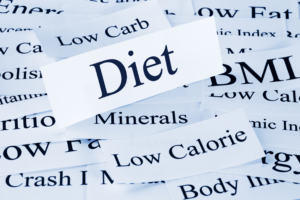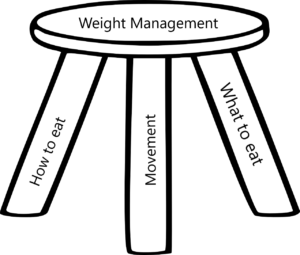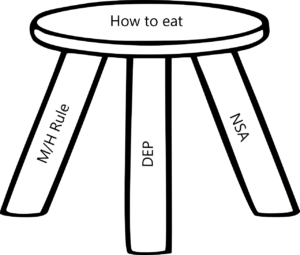Page Contents
More diets than sense
When you’ve been in the weight (aka diet) field as long as I have, you’ve pretty much seen it all. The Grapefruit Diet, the Beverly Hills Diet, the Blood Type Diet, the Cabbage Diet, Low Carb, High Carb, Sheep Urine, Keto, Ice Baths, Manic Mastication, … the list is endless.
 Since about the mid-20th-century, our appetite for diets has grown to gargantuan proportions! By 2019, we spent over $192 billion on weight loss products and projections are that this number will exceed $295 billion by 2027.
Since about the mid-20th-century, our appetite for diets has grown to gargantuan proportions! By 2019, we spent over $192 billion on weight loss products and projections are that this number will exceed $295 billion by 2027.
So you have to ask yourself, “With so many diet options and so many people spending so much money on them, why is obesity at an all-time high?” The answer is simple. We have more diets than we have common sense.
What does common sense tell us about diets?
If you have been on more than one diet and are still surfing the internet looking for diets, common sense dictates that you are looking for the wrong solution. You have dieted and dieted and are still struggling with excess weight. So stop dieting!
Diets that establish a caloric deficit do indeed cause weight loss. However, as you well know, that loss is almost always followed by regain. Another diet is not your best strategy. In fact, a diet is the last thing you need! (Isn’t that a great name for a book?)
Why don’t diets work?
The problem with diets, all of them, is that other people design them. When you start a new diet, you basically make the decision to eat the way someone else dictates. You are trading your preferences, your lifestyle, possibly even your family traditions for an alien structure.
You may be able to stick to the diet for a while but eventually it will wear you down and that will be the end of that. Following that alien diet may indeed cause some weight loss but it will not change all the desires and triggers that have caused you to overeat in the past. As a result, when you stop that diet, you will be right back where you started—struggling with weight.
What does work?
Successful long-term weight management is built on a three-legged stool built on three three-legged stools. (Nope, that’s not a typo. Read on.)
The three legs are how you eat, movement, and what you eat . Each of those legs, in turn, is held up by three legs of its own. No one leg is more important than the other so do not interpret the order in which I talk about them to imply order of importance. Keep that three-legged stool image in mind—if any one of those legs is broken, the whole thing topples.

How you eat is about the behaviors involved in getting food from its source (e.g., the fridge, pantry, plate, package) to your mouth. People who tend to eat quickly while doing other things, often realize at the end of a meal that had they stopped sooner, they would feel much better. Not paying attention to what is going into your mouth and down to your belly makes it easy to miss your body’s signal telling you hunger is fading away. Moreover, if you eat quickly, you will have finished everything on your plate (or in the family-sized bag of goodies) before your body has a chance to send that signal.
Having spent years fighting your weight with diets means you have spent years practicing not paying attention to your body’s signals of hunger and satiety (fullness). As a result, eating quickly while not paying attention means you are a slave to your environment. Whether hungry or full, if food is in front of you, you most likely will eat—and continue eating until it is gone. (For an in-depth discussion of how lack of body awareness and environmental triggers contribute to weight problems, see Diet is the Last Thing You Need: Weight Loss & Maintenance Answers.)
Movement is about using your body each day. Without physical activity, your body eventually atrophies. It becomes weaker and weaker, losing its ability to fight off infection and take you where you want to go.
What you eat is the thing that diets focus on. If you want to better manage your weight, you do need to think about what you eat—the foods and quantities you choose. But you do not need to eat what someone else wants you to eat. Indeed, you should not!
How to eat
Getting a handle on how you eat starts with three essentials.
- Mouth/Hand Rule (M/H): The M/H Rule means that while there is food in your mouth, your hands are empty. It is not until the current mouthful has been chewed and swallowed, (or simply swallowed if liquid), that you pick up your utensils, the food item, or the beverage container for your next mouthful. This accomplishes two things. The first, obviously, is it slows you down which gives your body a chance to recognize the influx of nutrients and signal that hunger is decreasing. The other result is that it breaks the automatic behavior of immediately refilling your mouth and gives you a moment to make a thoughtful decision about continuing to eat.
- Designated Eating Place (DEP): If you are in the habit of eating at your desk, in your car, on the sofa, in the basement, on the roof of your car—your brain links all of those places to eating. They all become eating triggers. As result, whether hungry or not, those places make you want to eat. Commit to eat only at a DEP such as your kitchen table or the school/work cafeteria. Doing so limits the number of places in your world that make you feel hungry. If you consistently use your DEP, it will be easier to resist excess snacking because there will be fewer places that bring it to mind. Also, the hassle of having to stop what you’re doing and move to your DEP will make you think twice.
- No Simultaneous Activities (NSA): This rule is very simple. While you eat, do nothing else other than chat with meal-mates or listen to music. The objective of NSA encompasses the objectives of both M/H and DEP. It helps you pay attention to how your body is feeling and reduces the number of activities that your brain automatically links to food/hunger.
Movement
 Food intake changes alone seldom lead to long-term weight management, and physical movement is important to more than just weight. Movement is the closest thing we have to a magical health and happiness elixir!
Food intake changes alone seldom lead to long-term weight management, and physical movement is important to more than just weight. Movement is the closest thing we have to a magical health and happiness elixir!
If you are struggling to keep your weight in a healthier range, that struggle will be easier if you increase your daily physical movement. However, do not immediately buy a lifetime gym membership or order expensive workout equipment for your home! Do it smart and start with these three considerations:
- Current ability: If you have been sitting on your tush for months or years, be honest with yourself about the fact that running a mile or climbing a mountain are not just impossible immediate goals, but downright dangerous. Realistically assess your current activity level and then set the goal of moving a little more than you do now. When that “little more” gets easier, add a little more. And please ignore all the fitness “gurus” who preach you need to do this much of that exercise or that much of this one to be healthy. If right now you can walk for three minutes before you get tired, then three minutes and 20 seconds is a terrifically healthy first goal!
- Preferences: Think about what physical activities you have enjoyed in the past or are interested in trying. If your current ability allows you to try those, go for it in small chunks, never pushing yourself past comfortably tired. If not, put those on the shelf for now and begin by standing up. If standing up is easy, walk as much as you comfortably can. Then walk 10 more steps. Gradually increase your movement, never making yourself hurt but consistently making yourself comfortably tired. Bit by bit, you will find it easier to do all sorts of enjoyable activities.
- Flexibility: If you find yourself losing interest in your movement routine, be flexible and change it up! Most of us don’t develop a lifelong passion for any particular physical activity. We enjoy something for a while, then lose interest and find it becomes a chore. The difference between people who maintain a healthy level of physical movement and those who don’t is that the maintainers flex!
What to eat
 Let me start by reminding you that I am a psychologist and not a Registered Dietitian. If you have any medical conditions that require specific food decisions, continue to follow your doctor’s or dietitian’s instructions.
Let me start by reminding you that I am a psychologist and not a Registered Dietitian. If you have any medical conditions that require specific food decisions, continue to follow your doctor’s or dietitian’s instructions.
As I explain in my book,
Regardless of whether you are a carnivore, herbivore, omnivore, or somewhere in between, there are three considerations you must incorporate into your food choices if you want to manage your weight for life:
Nutrition—Regardless of the specific menu strategies you choose, they must include a broad variety of foods that provide protein, carbohydrates, and fat to nourish your body. Severely restricting any one of the macronutrients will damage you physically, as well as set you up for cravings for the foods that you have made off limits.
Satisfaction—Select foods for the flavors and textures that please your palate. Following a meal plan with which your best buddy lost 100 pounds, but that forbids foods you like, may result in some weight loss but not lasting lower weight stability. When you are done with the unsatisfying plan, you will also be done with the weight loss.
Tradition—Along with nutrition and satisfaction, be sure to respect the traditions that are meaningful to you. Swearing off Mom’s apple cake that has been a beloved treat since you were a child, will only make you feel deprived and count the days till you are done with the diet. On the other hand, if you mindfully incorporate foods that evoke pleasing memories and emotions and complement special times, you can lose weight and have your cake too.
Why might you buy another diet book after reading this?
Because advertised diets promise quick results that sound easy to get, and what I offer here are simple behaviors that can be a hassle to stick with. However, if you stick with them, you will be happily surprised with the results. Further, if you ultimately decide that you do need a more structured eating plan, sticking to that will be made easier because of the behaviors you adopt today. A diet truly is the last thing you (may) need.
